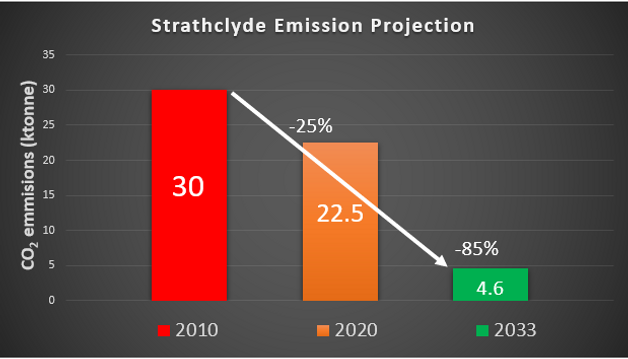
Transition Towards a Sustainable Strathclyde
Conclusion
Future Campus
Having carried out the technical and financial assessment for each strategy, the group reconvened to compare results and attempt to merge the strategies. The following section will outline our vision for a future campus.
CO2 Projections
The results from the strategies were combined to give a projection of the potential future carbon emissions if our strategies were implemented.
The first strategy, increasing efficiency, was discounted. This is because the system will need to be replaced after 2032 when the CHP is decommissioned. We foresee this first strategy as a method of generating revenue to support investment into other strategies. The following calculations show how the carbon emission results of the other three strategies develop into this future projection.
Firstly, the current heating demand of the university was taken as 43.3 GWh. From the retrofitting strategy, a demand reduction of 68% was predicted. This was applied to the campus as a whole:
It is accepted that this reduction of 68% will likely not be achievable in every building, an issue that will be addressed in a brief sensitivity analysis. Taking a 68% reduction in demand, the next step was to deduct the heating coverage provided by the WHR strategy. From those results, it was determined that a heating supply of 6.2GWh could be provided. This led to the remaining heating demand of the university being calculated:
It was assumed that this remaining heating demand would be supplied by natural gas boilers, ideally running at a 97% efficiency, leading to the calculation of the associated carbon emissions using the natural gas carbon emission factor (0.184(kg/kWh_th))
Since the CHP will no longer be providing electricity, it is assumed that the electricity demand of the university will be solely provided from the grid. Projected emission factors were used in this calculation and the year used was 2033, the year after the decommissioning of the CHP. The predicted value of this emission factor is 0.095 kg/kWh_e. The future electricity demand was unaltered from the 2021 data. Ideally, a future campus will be able to reduce this demand. With advancing BEMS and investment in efficiency (for example LED lighting), the requirement for such large grid purchases could be reduced. Included in the following calculation is the generation from the PV strategy being deducted from the overall demand.
This allowed us to calculate the carbon emissions associated with the electricity coming from the grid.
Thus, the total projected emission for 2033 were determined.
When looking back at the Strathclyde emission targets, the target for 2030 is surpassed with these strategies implementation, albeit, not until after the decommissioning of the CHP in 2033. Figure 1 shows an updated emission projection based on the target graphic seen here.
Figure 1: Projection of Strathclyde's emission
Having calculated the carbon emissions, the group decided to generate a possible future heat demand profile for the campus. Figure 2 shows this potential demand. The area in grey represents the current demand which is reduced to the green area by implementing our retrofitting strategy. The blue area of the graph shows the coverage of our WHR strategy for the possible future demand. When this blue area is higher than demand, the thermal energy storage installed during the increasing efficiency strategy can be utilised to store most of this energy for use when demand is not met by the WHR strategy, using a similar control scheme as outlined in strategy one.
Figure 2: Future Heat Demand Projection
Due to concerns about the likelihood of being able to retrofit the whole campus to a standard which reduces demand by 68%, we carried out a sensitivity analysis. We found that to achieve Strathclyde's target of carbon emissions lower than 6 ktonnes, a campus wide heating demand reduction of at least 52% would be required by 2033. This will be addressed in the closing statement.
Timeline
With the potential future carbon emissions calculated, it became clear to us that, in terms of implementation, there was a logical order in which to carry out the strategies.
Increasing the efficiency of the current system was something that the group believed could be implemented in a very short amount of time. Considering this strategy, it has a potential payback period of one year. The university could invest in this strategy knowing that revenue can be generated almost immediately. The group envisioned that part of this revenue generation could be invested into the expansion of the PV network. This is another short-term project that could create cash flow to support later strategies. Retrofitting was considered by the group as being a mid to long-term strategy. This is a costly endeavour as well as being time consuming.
However, with construction beginning as soon as possible and with financial backing (supported by the previous strategies) the university would be undertaking a project that is vital in reducing emissions. Until the buildings perform better, and demand is significantly lowered, reducing emissions will be an incredibly difficult task. Finally, in the long-term, the CHP must be replaced with a new energy system. The case study the group developed is a theoretical idea of how future energy systems in smart cities could work. To construct the waste heat recovery system described in the fourth strategy would once again take time and investment. This is unavoidable when looking at implementing a completely new energy system and the advantage of this case study is the carbon free energy that the university would be harvesting.
Closing Statement
The project relies on several factors. The peer-to-peer selling of electricity is a factor that could prove to be a hurdle when implementing the first strategy. After conversations with the university, this is not outside the realms of possibility. However, agreeing contracts with a suitable consumer can be a tedious and lengthy process which could slow down proceedings. For the other three strategies, construction is always an issue. Procuring planning permission and social backing for large construction projects can also take time and delay progress or halt them all together. Having said this, the group sees this project as an example of the kind of major actions and changes that the university must make if they hope to achieve their 2030 target. Sever measures will have to be implemented in the coming years to reduce emissions and this project, we believe, can act as a case study of how the university could potentially become a more sustainable campus. As seen from the carbon emission projections, this project is only providing steps on the road to carbon neutrality and there is even further work to be done still in meeting carbon zero.
Further Work
When looking at TES strategy, further investigation may show that doubling instead of tripling thermal energy storage may suffice. Phenomena such as heat losses and losses due to non-optimal stratification could be included in this work. A better understanding of savings vs. earnings from generating power could be reached using metered data of electricity in the same temporal resolution as heat. Thus, phenomena of differing prices (import vs. export) could be researched. In addition, a sensitivity analysis of efficiencies before and after might lead to insights into parameters of the highest leverage. In this process, the assumed electricity efficiency of 45% should be scrutinised since the value seems high.
Future work on the PV expansion could include further simulations on buildings throughout the campus, potentially using a more in-depth/sophisticated simulation tool that could produce more accurate results and daily generation data. Having studied and carried out this project on the John Anderson campus, the group noticed that there is a lot of room for improvement with the lighting controls around the campus since in many rooms, lighting seems to be on all the time. Further work could include looking at control systems to lower the electricity demand of the campus and thus increase the contribution of any solar arrays that may be installed.
The retrofitting strategy could be expanded by modelling more buildings on the campus to generate more reliable results in demand reduction. In addition, building energy management systems for monitoring and controlling the energy consumption of the buildings based on the specific demands should be designed and implemented.
Waste heat recovery reduces the environmental impact with great savings but due to several barriers mentioned above these technologies are not pursued to the full extent. Here, theoretical analysis was done only considering the case of Tennent Caledonian Breweries but there are many other potential sources in the surrounding. With the improvement of this technology in the future, the University may expand their system to involve partners such as Queen’s Street Station, Glasgow Royal Infirmary Hospital and many others as this solution is scalable and produces promising results.





